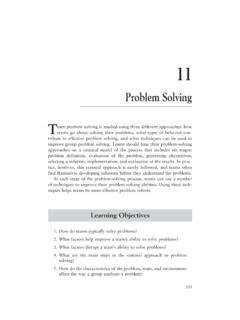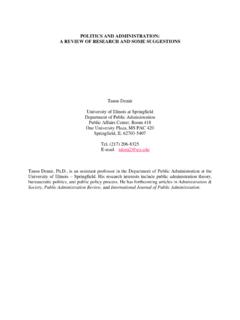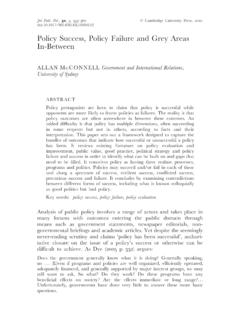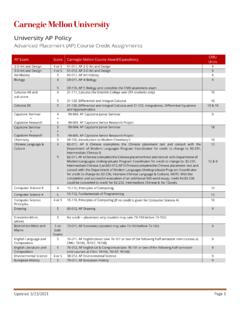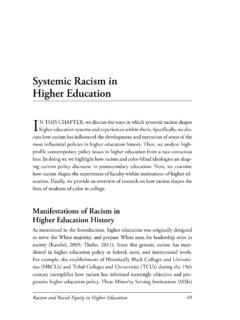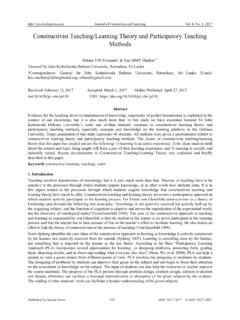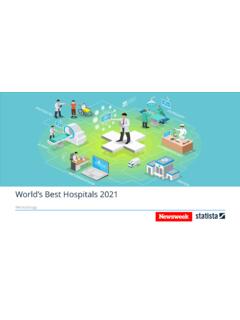Transcription of Participatory Action Research: An Overview
1 9 KAIRARANGA VOLUME 9, SPECIAL EDITION: 2008 Weaving educational threads. Weaving educational and reflect on implicationsPlan changes or actionsDevelop research questionCollect data and evidenceABSTRACTIn this article I outline different elements of Action research in an attempt to describe and define Participatory Action research (PAR). There is a lot more material available to readers these days, some of which I will refer you to in this article. I see my role here is to summarise enough of this material to help support your reading of the other articles that appear in this issue of Kairaranga.
2 This material (I have tried to use work from Aotearoa New Zealand in the first instance) refers to the ethical, political and context characteristics of PAR, as well as the design and format for conducting such research, definitions, effective practices, Participatory Action research, professional practice, first job as a graduate out of university was as a research assistant in an organisation establishing Action research projects within its different departments. However, in the various courses I had taken at university, I could not recall any reference to Action research.
3 When I went to the library to find material there was little available other than The Action Research Planner (Kemmis & McTaggert, 1982) and The Action Research Reader (Deakin University, 1982) both from Australia. Even then they had to be borrowed from another university years on and Action research has become a key approach for professionals to conduct research without needing to undertake large surveys or set up experimental conditions to test hypotheses. The underlying aim of Action research is not to produce knowledge, but to create social change in the settings within which it is used (Munford & Sanders, 2003).
4 Aligned with this increasing popularity has been the expanding New Zealand reading material available to support teachers and other professional groups in the use of Action research (eg, Cardno, 2003; Zepke, Nugent & Leach, 2003; Munford & Sanders, 2003).WHAT IS Participatory Action RESEARCH? Action research has often been linked to notions of professional development and the reflective practitioner, but not all material will refer directly to Action research itself (eg, O Connor & Diggins, 2002). Scouring the latest Best Evidence Synthesis released by the Ministry of Education Teacher Professional Learning and Development (Timperley, Wilson, Barrar & Fung, 2007) there was no reference to Action research, but the diagram on the inside cover sets out a format for learning that mirrors Action research cycles of inquiry.
5 That is, a person or group sets out a question of professional relevance to their current teaching context, this is usually in relation to student learning, and then activities and experiences are designed to answer or explore these questions, which the teacher(s) then implement(s). This is followed by the teacher or group evaluating the impact of the changed practices. The answers, or non-answers as the case may be, are meant to lead to new questions and the process continues in what is usually referred to as cycles or spirals of ongoing Action and reflection.
6 Figure 1 is a simplification of some diagrams and does not show the iterative nature of the research over time that Cardno (2003) refers to, but it does outline the underlying format based on identifying an initial question or problem to start GaffneyDeputy Director, Children s Issues Centre, Otago University, DunedinParticipatory Action Research: An OverviewWhat makes it tick?1 There were a small number of New Zealand articles in academic journals also available. See Alcorn (1986) and Marshall & Peters (1985, 1986) in 1. The Action research VOLUME 9, SPECIAL EDITION: 2008 Participatory Action research (PAR) has been described in much the same way as Action research with little to distinguish the two, depending on whom you are reading.
7 PAR has also been used as an acronym to remember the process: Planning a change, Acting and observing the process and consequence of change, Reflecting on these processes and consequences, and then replanning, acting and observing, reflecting, and so on .. (Kemmis & McTaggart, 2000, , bold added)With reference back to my first involvement in Action research, even though each group in the organisation followed the above format, it was surprising how different my experiences were as I worked with them to set up their projects. It ranged from large-scale work reviews involving all staff in a department, through to trying to resolve quite specific technical problems working alongside only one or two individuals.
8 Some projects moved very quickly and others felt as though they were always struggling to get started. The diversity of Action research despite this framework or process can be surprising. One key element of PAR that distinguishes it as a subset of Action research is the nature of participation by team members. Some writers assume that participation is always involved so do not see the need to add the qualifier Participatory (eg, Whitehead & McNiff, 2006) and others do (eg, Cardno, 2003). Others have distinguished PAR from Action research on the basis that PAR involves individuals with different roles participating as equal partners, such as when teachers and parents might work together, as opposed to teachers participating together as a professional group (Liamputtong & Ezzy, 2005).
9 I will return to the nature of participation later on in this the increasing use of PAR in New Zealand there have been a number of variations in the name used or the purposes to which it is put. In early childhood education, Action research is identifiable in the prepare, gather, make sense, decide cycle in the Nga Arohaehae Whai Hua: Self Review Guidelines (Ministry of Education, 2006a) and in the plan study do act cycle in the Quality Journey: He Haerenga Whai Hua (Ministry of Education, 2000), both provided as a resource to improve the quality of early childhood education in New Zealand.
10 As these two examples show, there has been a strong link between internal or self-evaluation/review methodologies and Action research. Other examples include The Cultural Self-Review (Bevan-Brown, 2003) and Participatory evaluation (Patton, 1997). More recently the Ministry of Education has funded the Teaching and Learning Research Initiative (TLRI) (Sandretto, 2008) and the early childhood education Centres of Innovation (COI) (Meade, 2006) programmes, which ask practitioners and researchers to collaborate in Action research as a means of developing and researching innovative practice.










